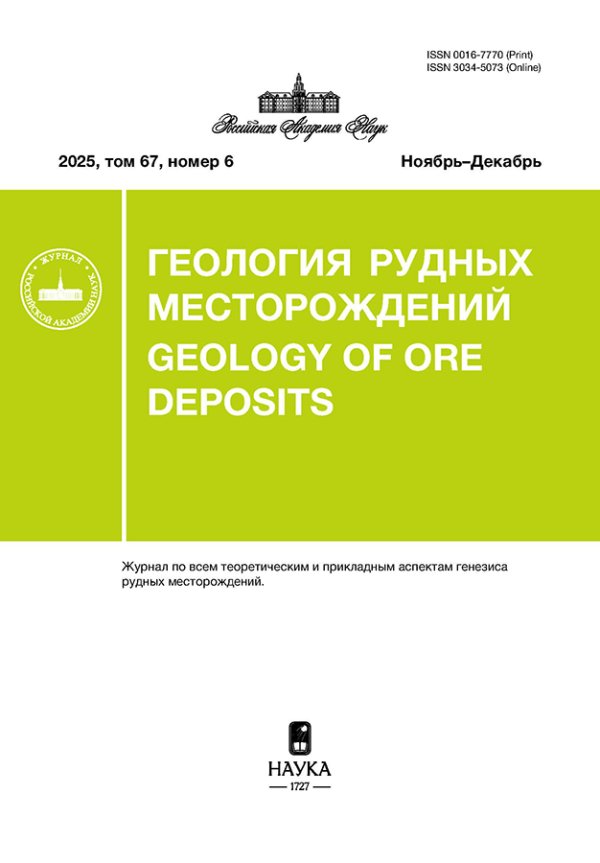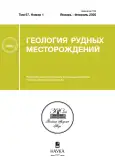Vol 67, No 1 (2025)
Articles
Hydrothermal tin and tungsten deposits: historical aspects and present directions of research (to the 115th anniversary of O.D. Levitsky)
Abstract
The paper considers the main results of the works by O.D. Levitsky in studying tin and tungsten deposits and their further development in the context of the evolution of the metallogenic theory. His input to the modern metallogenic classification of tin and tungsten deposits is recognized, with distinguishing the types of tungsten-polymetallic and tin-polymetallic deposits related to the intrusions of the deeply-derived mafic magma, in contrast to tin-tungsten deposits related to granitoid igneous suites dominantly of the crustal nature. According to the metallogenic views of O.D. Levitsky, a control of large tin and tungsten mineralized districts, as well as the deposits within these districts, by large “concealed” faults (“photolineaments”) was demonstrated, together with the relationships of the districts to the variously-sized “chamber” structures, with the characteristic leveled distribution of ore mineralization. The works by O.D. Levitsky paid significant attention to the mineral stages and zonation of tin and tungsten deposits, with distinguishing post-greisen stages of mineralization including quartz-tourmaline-chlorite metasomatites and later lower-temperature metasomatites comprising light micas, in contrast to greisens referred to as phyllic and carbonate-phyllic alteration. He justified a pulsing centrifugal “case-covering” mineral and ore zonation at some Sn deposits. A viewable place in the works by O.D. Levitsky is given to the peculiarities of mineral-forming fluid composition at Sn and W deposits, aggregate state of the fluids, and their evolution during the multi-stage ore formation. He paid particular attention to the existence of collomorphic cassiterite varieties, which are high-temperature and formed at the early stages of post-magmatic ore-formation. Some modern directions in studying tungsten and tin deposits are considered, including classification of Sn and W deposits and their positions in the series of related metallogenic types of ore deposits, possibility of the mantle sources of the productive magmatism, metals and fluids, some aspects of distinguishing hydrothermal stages related to the evolution of multi-phase magmatic intrusions, possible role of the “transmagmatic” fluids, and the aspects of unified systematics of hydrothermal-metasomatic formations at ore deposits.
 3-28
3-28


Mineralogical and geochemical characteristics of scheelite from the Vostok-2 au-bi-cu-w skarn deposit (Primorsky krai)
Abstract
The scheelite (CaWO4) is main ore mineral from the Vostok-2 reduced skarn type deposit, which located in Primorie region (Russia) and connected with the Sikhote-Alin central fault. By mineral composition and geochemical characteristics ore rocks were divided into two most common types: skarns and quartz-veins. This study presented results of complex (mineragraphy, cathodoluminescence (CL), electron-probe microanalysis (EPMA), laser-ablation inductively-connected plasma mass-spectrometry (LA-ICP-MS)) researching of scheelite. These parameters for scheelite like inner structure, illumination character in CL and UV, contents of micro- and macroimpurities, Eu/Eu* value, REE spectral shape are crucial indicators of the conditions of mineralization. These signs allowed to identify different mechanism of REE entering in scheelite from skarns and quartz-veins (3Ca2+ ↔ 2REE3+ + □ and Ca2+ + W6+ ↔ REE3+ + Nb5+ where □ is vacancy in the Ca site). By distribution specific of REE three types of scheelite were identified and their temporal relationships were established. Because scheelite inherits REE characteristics from mineral-forming environment some conclusions were shown: evolution of the ore-forming fluid, pulsation nature of the substance’s intake and its single source, and reductive conditions of mineralization were proved for the deposit as a whole.
 29-49
29-49


Mineralogical and geochemical characteristics of scheelite from the Vostok-2 au-bi-cu-w skarn deposit (Primorsky krai)
Abstract
The scheelite (CaWO4) is main ore mineral from the Vostok-2 reduced skarn type deposit, which located in Primorie region (Russia) and connected with the Sikhote-Alin central fault. By mineral composition and geochemical characteristics ore rocks were divided into two most common types: skarns and quartz-veins. This study presented results of complex (mineragraphy, cathodoluminescence (CL), electron-probe microanalysis (EPMA), laser-ablation inductively-connected plasma mass-spectrometry (LA-ICP-MS)) researching of scheelite. These parameters for scheelite like inner structure, illumination character in CL and UV, contents of micro- and macroimpurities, Eu/Eu* value, REE spectral shape are crucial indicators of the conditions of mineralization. These signs allowed to identify different mechanism of REE entering in scheelite from skarns and quartz-veins (3Ca2+ ↔ 2REE3+ + □ and Ca2+ + W6+ ↔ REE3+ + Nb5+ where □ is vacancy in the Ca site). By distribution specific of REE three types of scheelite were identified and their temporal relationships were established. Because scheelite inherits REE characteristics from mineral-forming environment some conclusions were shown: evolution of the ore-forming fluid, pulsation nature of the substance’s intake and its single source, and reductive conditions of mineralization were proved for the deposit as a whole.
 50-69
50-69


Metallic inclusions in natural diamonds and their evolution in the postcrystallization period
Abstract
Based on experimental results on the growth of diamonds and the phase diagram of the iron-carbon system at high pressures and temperatures, an analysis of the conditions of phase formation in metal inclusions in natural diamonds from kimberlites was carried out. Metallic inclusions are present in both lithospheric and sublithospheric diamonds associated with both peridotite and eclogite assemblages of mantle minerals. It is argued that the equilibrium phases at the post-crystallization stage of the genesis of natural diamonds are iron carbides and oxides; the presence of native metals in inclusions indicates that equilibrium has not been achieved. The presence of native iron in inclusions also indicates a high rate of decrease in pressure and temperature at the post-crystallization stage of the genesis of natural diamonds. The change in P-T parameters during diamonds transportation to the Earth's surface probably occurred as an explosion process characterized by a rapid pressure decrease and high temperature maintaining for some time.
 70-84
70-84


Научная дискуссия
Periodicity and kinematics of the formation of porphyry copper deposits in the pacific belt over the past 125 million years
Abstract
Statistical analysis of the time series of Cu-porphyry deposits of the Pacific belt and their total ore volume formed in the last 125 million years showed the presence of (quasi)a cyclic component with a period of 26–28 million years, whose share in the total amplitude is 74%. An inverse correlation has been established between the global spreading rate, on the one hand, and the number of Cu-porphyry deposits in the Pacific belt and their productivity, on the other, for the last 125 million years. The relative minima of the spreading rate precede the relative maxima of the number and total volume of Cu-porphyry deposits in the Pacific belt by 5–10 million years. During the formation of large and giant Cu-porphyry deposits in the Pacific belt, the rate of change in the angle of convergence in the horizontal plane in the zone of interaction between two tectonic plates increases. At the same time, the absolute rate of convergence can both decrease and increase. According to geological, structural and kinematic data, magmatism, as a result of which 8 large and giant Cu-porphyry deposits were formed, was accompanied by through-crust disjunctive disturbances associated either with a change in the frontal convergence of the "oblique", or a transition to the mode of a transform continental margin, or with a reversible change in the direction of subduction associated with the island arc-continent collision The island arc is an oceanic plateau.
 85-116
85-116












